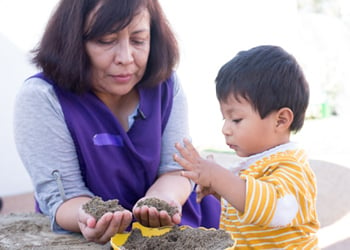
Often, when I am engaged in professional development focusing on vocabulary lessons with teachers in bilingual classrooms, I am asked “Should I speak to the child in English or Spanish?” My answer is never simply one or the other.
It’s a complicated, immediate calculation of a number of factors: the child’s age, home language, socioeconomic status, and the dominant language—all variables described in the works of Uccelli & Páez (2007).
This usually leads to more questions from teachers! And I haven’t even asked them to look at if the child is decoding in English or their comprehension skills. As you can see, this topic is, indeed, complicated. Ongoing research has helped enrich my answer.
Teachers I encounter often do an amazing, powerful job of introducing new vocabulary and increasing the students’ phonological awareness in interesting and engaging ways, such as chants, songs, repetition, tactical kinesthetic means, as well as back-and-forth discussions. But, what else matters for our DLL children?
A recent study in the Early Childhood Research Quarterly (Hindman & Wasik 2015) offered a deeper look into various child, family, teacher, and classroom factors. What stood out for me? The critical role interactions play toward children’s vocabulary acquisition.
The study suggests that during high quality instructional support interactions, we should look not just to the act of teaching vocabulary, but to the interaction itself as a tool to increase the child’s comprehension.
Sometimes, managerial tasks get in the way of these interactions. It’s hard to focus on these intentional interactions while cleaning up breakfast, setting up for circle time, and anticipating center time. When I talk with my teachers, many relate this challenge of balancing managerial tasks to the fact that the vocabulary levels of their dual language learners are not increasing.
When deciding whether to use English or Spanish in your classroom, think about how you can really stretch that child’s understanding and learning. It might be that you use both to make the child feel most comfortable and to make the connections needed.
When coaching, I have teachers ask themselves, “Have I introduced new vocabulary, and if so, did I provide a quality interaction and engaging experiences for my dual language learner?” I also express that although setting the stage (e.g., lesson plans) is very important, it shouldn't take away from the quality of the informal interactions that might be less threatening for the new language learner. These informal interactions open up opportunities for children to take a risk using new words and sounds. In the end, I find that relationship and rapport building are just as essential, if not more important, in setting the stage for learning. So, the questions I pose at the end of each DLL training are:
- “What are some strategies that have worked for you, which encourage the participation of your dual language learners?”
- “Why did they work?”
I’d love to ask you the same question. Tell us (in the comments section below) some of the strategies that have worked for you and have encouraged the participation of your dual language learners. Why did they work?
Rogelio Chapa is an InSpire Education Professional ECE Training Consultant in California. Previous to that he was an MTP Coach and CLASS observer with Child Development Training Consortium for First 5 CA's CARES Plus program. As an MTP bilingual coach he worked directly with early child care providers across the state of California following this evidence-based coaching model.

